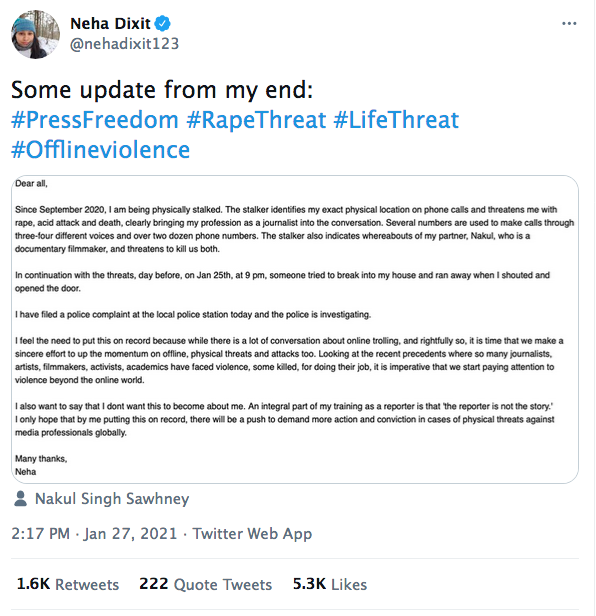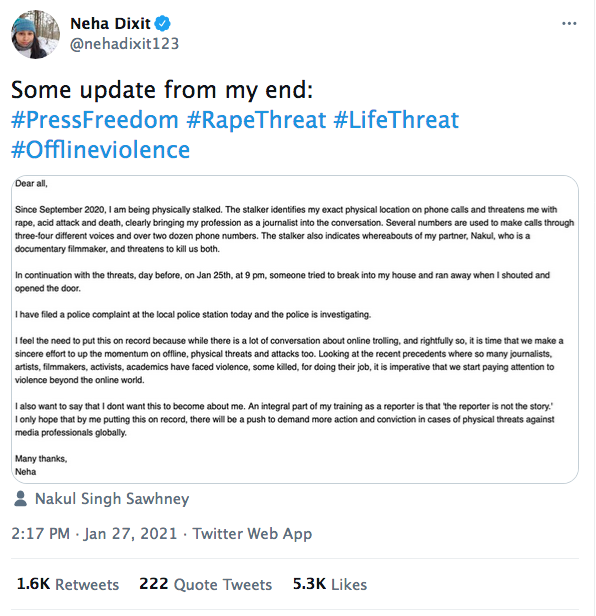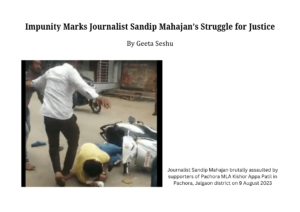
By Geeta Seshu
Journalist Neha Dixit was no stranger to online trolling but for the last five months, the harassment took an even more sinister turn, with callers stalking her, calling up on her phone from random numbers to issue rape and death threats and also attempt to break into her residence on the night of January 25.
The callers, speaking in different voices and using multiple numbers, referred to her exact physical locations and to her journalistic work. The unnerving monitoring of her movements and the threat calls also included her partner, filmmaker Nakul Sawhney, referring to his absence from their residence or to his work.

An award-winning journalist, Neha Dixit had faced online harassment and was charged with defamation and attempt to disrupt communal harmony after the publication of her five-part investigation, entitled ‘Operation #BabyLift”, into the trafficking of young girls from Assam by the Sangh Parivar in Outlook magazine in July-August 2016.
In a statement, the Network of Women in Media India condemned the attack and said that this is ‘not the first time Neha Dixit has been targeted online, although we note with concern that the threats have now been taken offline, ‘ adding :
“This instance is the latest in a long list of cases of women journalists being harassed and trolled for their work. Apart from Neha Dixit, right wing trolls have launched online attacks ranging from misogynist abuse and communal profiling to rape and death threats to writer-activist Meena Kandaswamy, journalists Anuradha Bhasin, Anna M.M. Vetticad, Dhanya Rajendran, Kavin Malar, Rana Ayyub, Sandhya Ravishankar, Supriya Sharma, Arfa Khanum Sherwani, and Barkha Dutt, to name just a few in the recent past. We know all too well from experience that online abuse and threats can translate into offline violence. Ms Dixit’s narrow escape this weekend is a terrifying reminder of this reality.”
Attacks against journalists in India continue unabated. Amidst near-total impunity, the attackers – be they police and security forces, local politically connected mafias controlling illegal activities like sand mining or mobs who target journalists covering conflict and charged issues like the Sabarimala temple entry or student protests.
In some of the most vicious instances in the recent past, journalists have had acid thrown on them, forced to drink liquor and even been urinated upon. They have been fired upon, blinded by pellet guns, kicked, beaten and chased. They have had petrol bombs thrown at their homes and the fuel pipes of their bikes cut.
Impunity is underscored in report after report by various organisations on the killings and attacks on journalists in India (See CPJ Global Impunity Index 2020 report here, the RSF Press Freedom Index 2020 report here and the IFJ South Asia Press Freedom Report – States of Control: Covid, Cuts and Impunity report here).
In a study on the killing and attacks on journalists between 2010-19 done by this writer and Urvashi Sarkar (Getting away with Murder, Thakur Foundation, December 2019), we pointed out that the targeted attacks on
journalists for investigative stories reveals the arrogant power and entitlement of the assailants, secure in their confidence that they enjoyed a great degree of impunity The professional reasons for the killing – the investigative stories the journalist was trying to bring to the fore- are almost never investigated. With the result, the stories the journalist has tried to tell are also forgotten.
That’s exactly what happened in the story filed by Neha Dixit. The magazine’s editor was forced to quit barely days after the publication of the story and prominent spokespersons of the BJP came out to attack her credentials. The cases lodged against her, filed by SC Koyal, Assistant Solicitor General of India at Guwahati High Court and Bijan Mahajan, then spokesperson of the Bharatiya Janata Party and now convener of the BJP’s legal cell in Assam, are still on.
The story of the young girls, as also a number of other important reports and investigations by journalists across the country, slide off the radar.
Killing, Attacks, Criminal Cases
Apart from the killing and the direct physical attacks, there is a sharp rise in cases lodged against journalists in India for their professional work. Charge range from alleged anti-national activity under the nefarious Unlawful Activities (Prevention) Act (UAPA), 1967, sedition, attempt to disrupt communal harmony, defamation, attempt to obstruct a public servant and other charges under the Indian Penal Code and as we witnessed during the lockdown due to the Covid-19 pandemic, chargers under the Disaster Management Act, 2005 and the Epidemic Diseases Act, 1897.
Currently, two journalists – Aasif Sultan and Siddique Kappan – are in jail, on charges under the UAPA while a third, Prashant Rahi, has been convicted and sentenced to life imprisonment. At least 52 journalists were arrested in the last decade, the FSC study revealed.
When the state and its agencies are clearly involved in the targeting of journalists for their work, when the state’s law enforcing agencies are directly responsible for the absence of any serious investigation into these attacks and when prominent spokespersons of the ruling political party join in the defamation of the journalist, the story they seek to tell invariably gets buried.
Speaking truth to power is a great slogan but when speaker after speaker is systematically targeted, attacked, jailed or killed, those in power will do everything in their power to stop people from speaking out. And journalists are not the only ones targeted. Scores of citizens who speak out or express political opinions on social media or even in private Whatsapp groups, film-makers, theatre persons, artists, stand-up comedians, students, lawyers…the growing list of cases and attacks is a constant reminder of the precarious nature of the right to freedom of expression we are guaranteed under the Constitution.
Read Neha Dixit’s public statement:
Dear all,
Since September 2020, I am being physically stalked. The stalker identifies my exact physical location on phone calls and threatens me with rape, acid attack and death, clearly bringing my profession as a journalist into the conversation. Several numbers are used to make calls through three-four different voices and over two dozen phone numbers. The stalker also indicates whereabouts of my partner, Nakul, who is a documentary filmmaker, and threatens to kill us both.
In continuation with the threats, day before, on Jan 25th, at 9 pm, someone tried to break into my house and ran away when I shouted and opened the door.
I have filed a police complaint at the local police station today and the police is investigating.
I feel the need to put this on record because while there is lot of conversation about online trolling, and rightfully so, it is time that we make a sincere effort to up the momentum on offline, physical threats and attacks too. Looking at the recent precedents where so many journalists, artists, filmmakers, activists, academics have faced violence, some killed, for doing their job, it is imperative that we start paying attention to violence beyond the online world.
I also want to say that I don’t want this to become about me. An integral part of my training as a reporter is that ‘the reporter is not the story.’ I only hope that by me putting this on record, there will be a push to demand more action and conviction in cases of physical threats against media professionals globally.
Read Getting away with Murder, Thakur Foundation, December 2019 here
Read Behind Bars: Arrests and Detentions of Journalists in India 2010-2020 , Free Speech Collective, December 2020 here



1 thought on “Unabated Attacks: Journalist Neha Dixit faces stalking, threats and attempted break in”